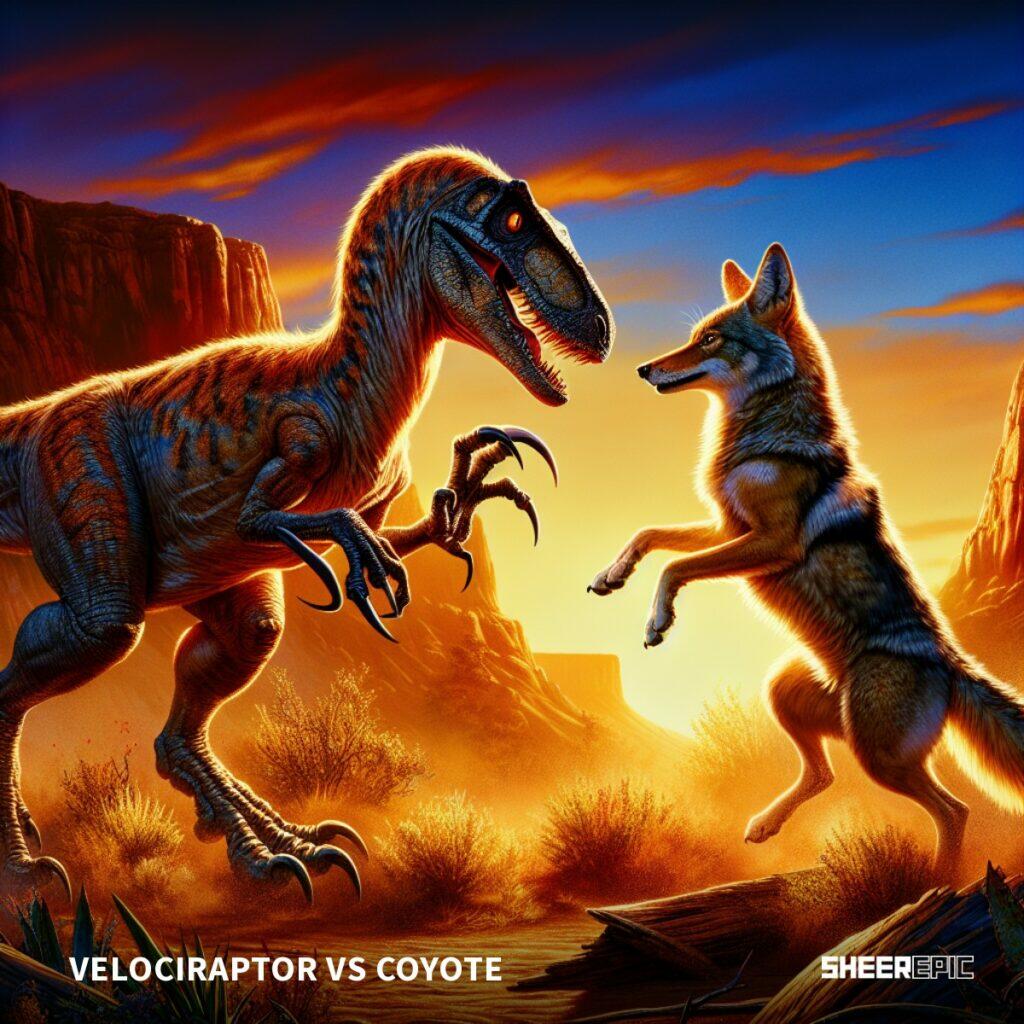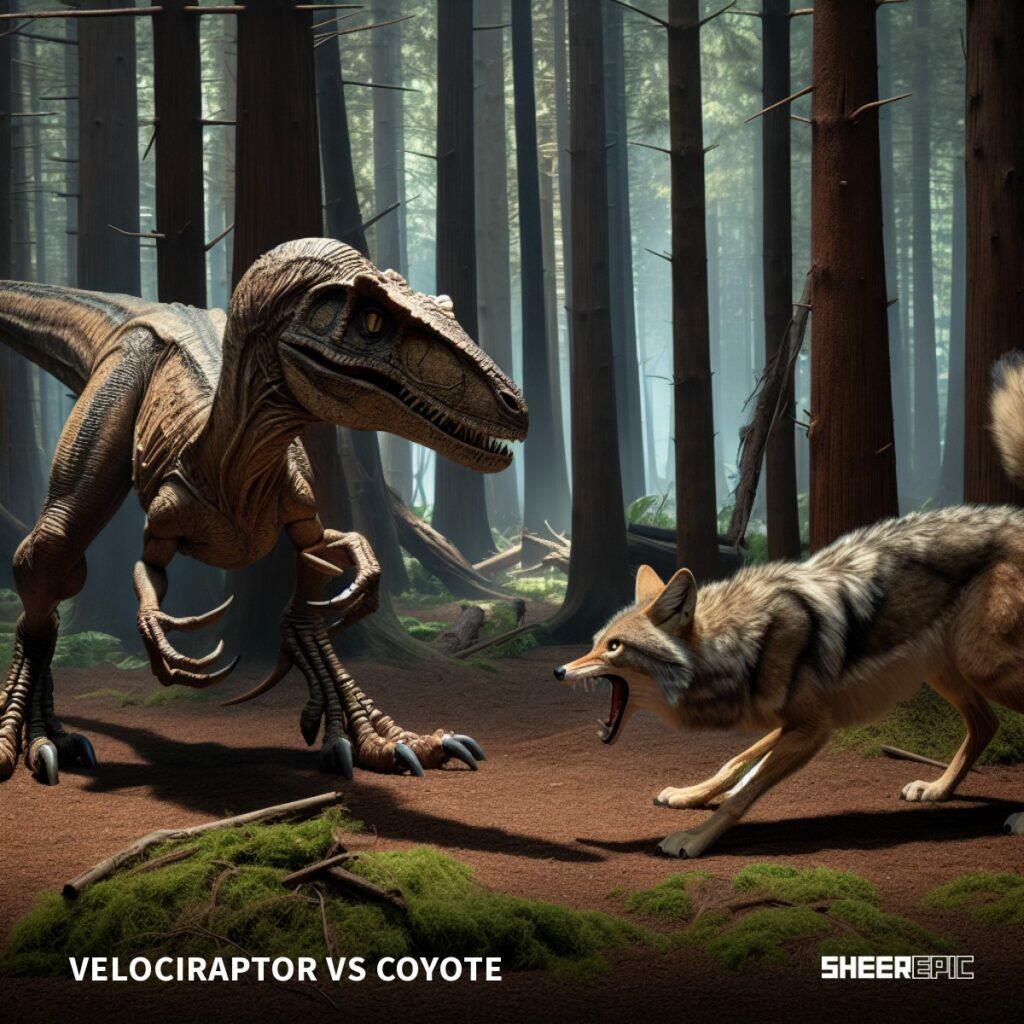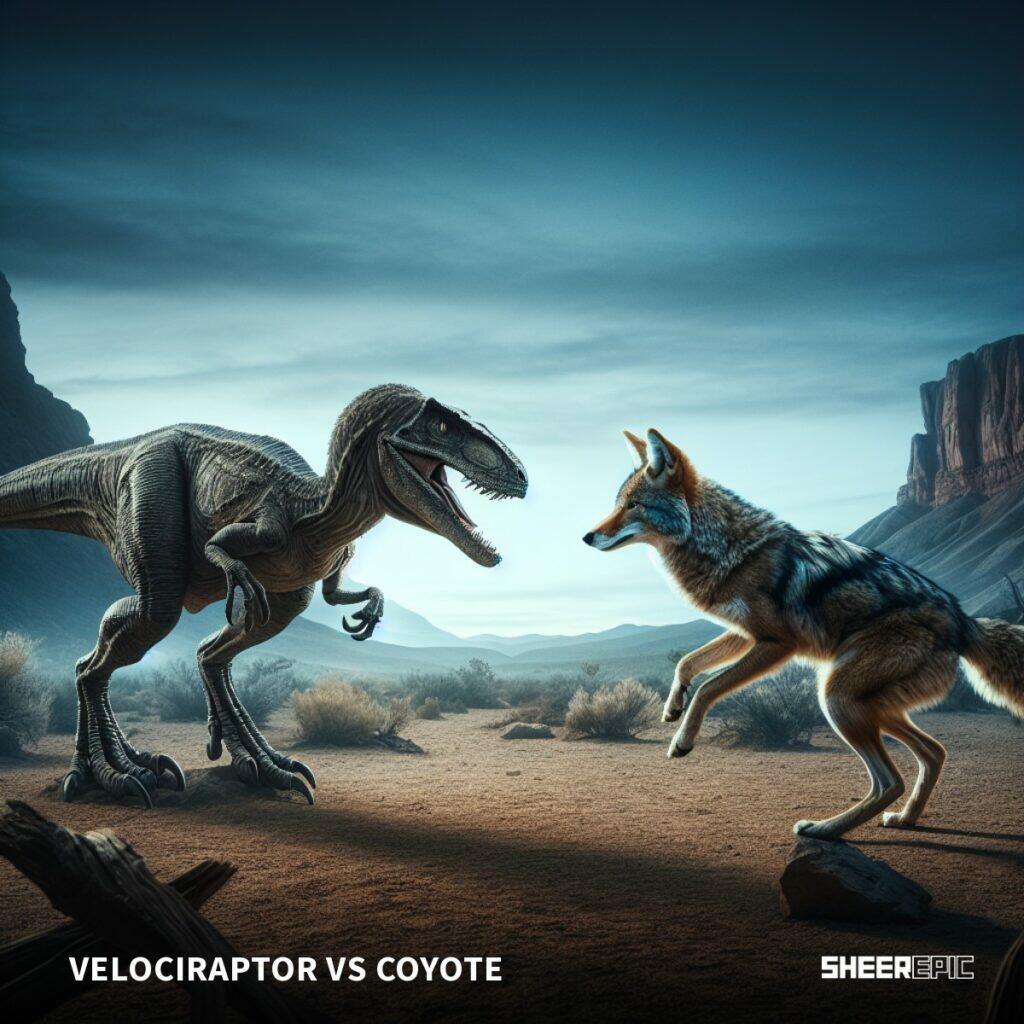The Velociraptor and the coyote are two fascinating creatures that have both captured the human imagination. Velociraptors roamed the earth during the Late Cretaceous epoch, about 75 million to 71 million years ago, exhibiting swift and agile predatory behaviors.
On the other hand, coyotes are modern-day canines native to North America, known for their intelligence and adaptability. While these animals never coexisted, it is intriguing to examine their respective abilities and characteristics to determine who would come out victorious in a hypothetical showdown.
To compare Velociraptors and coyotes, it is essential to consider their physical traits, hunting techniques, and defensive capabilities. Both species have unique adaptations that enable them to be efficient predators in their environments.
Additionally, examining their intelligence and social behaviors sheds light on how they could strategize in a potential battle.
Key Takeaways
- Comparing velociraptors and coyotes involves examining physical traits and hunting techniques
- Defense mechanisms and intelligence play a role in determining a potential winner
- The hypothetical showdown is a fascinating way to learn about the strengths and weaknesses of these two predators.
Table of Contents
Comparison
The Velociraptor and the coyote were two completely different animals, living in separate times and environments. However, it is fascinating to imagine what might have happened if these two predators had ever met in a hypothetical face-off.
The Velociraptor was a small dromaeosaurid dinosaur that inhabited Asia during the Late Cretaceous epoch, about 75 million to 71 million years ago. It was a swift predator, measuring approximately 2 meters in length and 0.5 meters in height, with an estimated weight of 15-20 kg. This dinosaur had a very distinctive feature: a long, curved, sickle-shaped claw on each foot, which it used for hunting and attacking its prey.
On the other hand, the coyote (Canis latrans) is a modern-day species of canine native to North America. This mammal is smaller than a wolf, with an average weight of 6.8 kg to 21 kg and a height of up to 0.66 meters. Coyotes are known for their speed and agility, with the ability to sprint up to 56 km/h when chasing prey.
Both the Velociraptor and the coyote were predators in their respective environments. While the velociraptor is believed to have been a solitary or small group hunter, the coyote is renowned for its adaptable hunting strategies – sometimes operating alone, sometimes in pairs or family groups, and occasionally joining forces with other species.
In terms of size, the Velociraptor had a slight edge over the coyote, being longer in length. However, the coyote would have a height advantage, standing taller on its legs. The sickle-shaped claws of the Velociraptor would be lethal weapons that could deliver a swift and powerful strike to the coyote’s body in an attack.
Despite these differences, the coyote’s speed and adaptability in hunting strategies could give it a fighting chance against the Velociraptor. In general, determining a winner between the two animals would be highly speculative, depending heavily on situational factors such as terrain, the presence of distractions or opportunities to employ surprise, and the overall health and condition of the animals during a confrontation.
Physical Characteristics
Comparison Table
| Attribute | Velociraptor | Coyote |
|---|---|---|
| Family | Dromaeosauridae (Dinosaurs) | Canidae (Mammals) |
| Species | Velociraptor mongoliensis | Canis latrans |
| Size (Length) | 6.8 ft (2.07 m) | 3.2 – 4.5 ft (0.97 – 1.37 m) |
| Weight | 33 – 55 lbs (15 – 25 kg) | 15 – 50 lbs (6.8 – 22.7 kg) |
| Height | 1.6 ft (0.5 m) hip height | 1.9 – 2.2 ft (0.58 – 0.67 m) |
| Speed | Up to 40 mph (64 km/h) | Up to 40 mph (64 km/h) |
| Key Factors | Long Claw, Agility, Hunting in Packs | Stamina, Adaptability, Keen Senses |

Key Factors
Velociraptor
Velociraptors were relatively small, fast predators. The most notable physical characteristic of Velociraptors was their large, sickle-shaped claw on each foot, which they could use to deliver powerful, slashing attacks. Interestingly, they were also covered in feathers, as part of the Dromaeosauridae family, though they were not capable of flight. Agility and hunting in packs were their two main advantages, allowing them to take down prey larger than themselves, such as the larger dinosaur, Deinonychus. However, the Velociraptor was much smaller than the Tyrannosaurus rex.
Coyote
The coyote is a versatile and adaptable mammal, often thriving in a variety of environments and habitats. They are well-known for their running speed, which can reach up to 40 mph, and their keen senses of hearing, smell, and sight. The coyote’s stamina far exceeds that of the velociraptor, enabling them to chase down prey over long distances. While they typically hunt smaller animals, coyotes have been known to join packs to bring down larger prey. Predator-sizing skills, adaptability, and keen senses are key factors in their survival and success.
Diet and Hunting
Velociraptors were small, carnivorous dinosaurs that lived in Asia during the Late Cretaceous epoch, about 75 million to 71 million years ago. Their diet primarily consisted of small mammals, reptiles, and other animals they could overpower and kill. Known for their sickle-shaped claws and sharp teeth, velociraptors were skilled hunters. They used their sharp, curved claws to pierce their prey’s skin and grip onto their bodies. Targeting vital areas on their prey, velociraptors could efficiently dispatch their targets even if the animal was larger than them.
On the other hand, coyotes are mammals native to North America, where they hold a similar ecological niche as the golden jackal in Eurasia. Coyotes are versatile predators, adapting their hunting behavior based on available prey. They primarily hunt small mammals, such as rabbits, rodents, and birds but are also known to scavenge on carrion or feed on fruits and insects when necessary. Coyotes often hunt alone or in pairs, but when faced with larger prey, they may form packs to increase their chances of success.
In comparing the hunting abilities of these two animals, it is important to note that velociraptors were more adapted for quick and powerful strikes with their claws, while coyotes rely on their endurance, agility, and cooperative hunting.
Additionally, their habitats would have varied significantly, with velociraptors inhabiting prehistoric Asian regions and coyotes residing in modern-day North America. This difference in environment would have influenced the types of prey available to each species as well as their hunting strategies.
Defense Mechanisms
Comparing the defense mechanisms of velociraptors and coyotes, velociraptors posess a more specialized method of attack with their long, sickle-shaped claws. These claws were specifically designed for slashing and piercing movements, which would have made them a formidable opponent in their time. Their agile bodies and keen senses also aided them in hunting and evading predators.

Coyotes, while not as specialized in their attack methods, are still equipped with defensive tools. Their strong teeth and powerful jaws make them capable of defending themselves and defeating smaller animals in a fight. Additionally, the coyote’s speed, agility, and ability to adapt to various environments allow it to outmaneuver potential threats and secure victory in a battle.
Intelligence and Social Behavior
In terms of intelligence, it is difficult to directly compare the cognitive abilities of Velociraptors and coyotes due to the vast differences in their brain structure and evolutionary history.
However, some insights can be drawn from the study of non-human primate cognition as well as their respective hunting behaviors.
When it comes to social behavior, it is widely believed that Velociraptors were pack hunters, working together in groups to take down larger prey. This cooperative hunting behavior showcases a certain level of social intelligence and coordination among these prehistoric predators that goes beyond mere instinct.
Similarly, coyotes also display social behavior, often hunting in small groups called packs. Their ability to communicate, coordinate, and work together is seen as evidence of their social intelligence.
Although the true extent of the cognitive capabilities of Velociraptors remains speculative, their pack-hunting behavior suggests that they may have had a level of social intelligence comparable to the coyotes.
On the other hand, coyotes are known for their adaptability and cleverness which allow them to thrive in varied environments, making them a rather resourceful predator.
Who Would Win?
In a hypothetical battle between a velociraptor and a coyote, several factors come into play. Velociraptors were known to be swift, agile predators, capable of reaching speeds up to 24 mph. This attribute, combined with their sharp, curved claws and keen hunting instincts, made them formidable adversaries in their prehistoric environment.
On the other hand, coyotes are also agile and fast, reaching speeds of up to 40 mph. With a strong sense of smell and larger brain size compared to velociraptors, coyotes benefit from more advanced strategies when it comes to hunting prey.
While both the velociraptor and coyote have unique advantages, a battle between these two species could resemble a high-stakes game of strategy, with each trying to outmaneuver the other. In this intense skirmish, the strengths of each combatant would be put to the test, as both employ a diverse arsenal of techniques to assert dominance.

It’s essential to remember that comparing modern animals like coyotes to prehistoric creatures like velociraptors can lead to some wild speculations. Planet-exploding battles featuring fictional gods with colossal powers might make for an entertaining read or visual, but it’s crucial to maintain scientific accuracy in any analysis.
Some enthusiasts of such imaginary battles may visualize a velociraptor, armed with a gladiator’s sword, slicing through the air while a coyote leaps fearlessly, prepared to kick some serious tail in retaliation. While intriguing, such embellishments may steer discussions away from meaningful, factual comparisons.
To sum up, both the velociraptor and coyote possess a mixture of speed, agility, and physical weaponry that could be used to their advantage. The outcome of such a battle is difficult to predict, but it is both fun and informative to imagine the various strategies each contender might employ as they vie for supremacy.
Frequently Asked Questions
How do velociraptors and coyotes compare in size?
Velociraptors were small dromaeosaurid dinosaurs that lived in Asia during the Late Cretaceous epoch, about 75 million to 71 million years ago. They were relatively small, measuring around 2 meters (6.5 feet) in length and weighing approximately 15 kg (33 lbs). Coyotes, on the other hand, are medium-sized canines native to North America, weighing between 15 to 46 lbs. and measuring approximately 4 to 5 feet in length, including their tails. In terms of size, velociraptors and coyotes were somewhat similar.
What are the key strengths of velociraptors?
Velociraptors were agile predators with sharp, sickle-like claws on their second toes and strong, grasping hands. These features allowed them to efficiently catch and subdue their prey. Their swift speed and powerful legs also gave them an advantage in pursuing small, fast-moving prey.
What are the main advantages of coyotes in a fight?
Coyotes are known for their intelligence, adaptability, and opportunistic hunting behavior. They are capable of taking down larger prey when hunting in packs, and their keen sense of smell helps them track down and evade potential threats. Their agility, endurance, and powerful bite also provide them with considerable advantages in a fight.
How do velociraptors and wolves compare?
Wolves are larger, more social, and have a greater capacity for cooperative hunting than either velociraptors or coyotes. While velociraptors were agile and had powerful claws, wolves have more massive jaws and can deliver a much stronger bite. Additionally, wolves hunt in packs, whereas it is still uncertain whether velociraptors hunted in groups.
Who would win between a velociraptor and a lion?
It is difficult to compare creatures from different time periods and ecosystems directly. Lions are much larger and stronger than velociraptors, with a more powerful bite and highly developed hunting skills. While the velociraptor might have been agile and had sharp claws, it is unlikely that it would be able to successfully compete with a lion in a hypothetical encounter.
How does a velociraptor matchup against a tiger?
Similar to the comparison with lions, it is challenging to determine the outcome of a hypothetical matchup between a velociraptor and a tiger. Tigers are larger, heavier, and equipped with powerful jaws and strong muscles. They are also excellent hunters with impressive stealth and agility. Although velociraptors were quick and had sharp claws, it is highly doubtful that they could triumph over a tiger in a confrontation.


